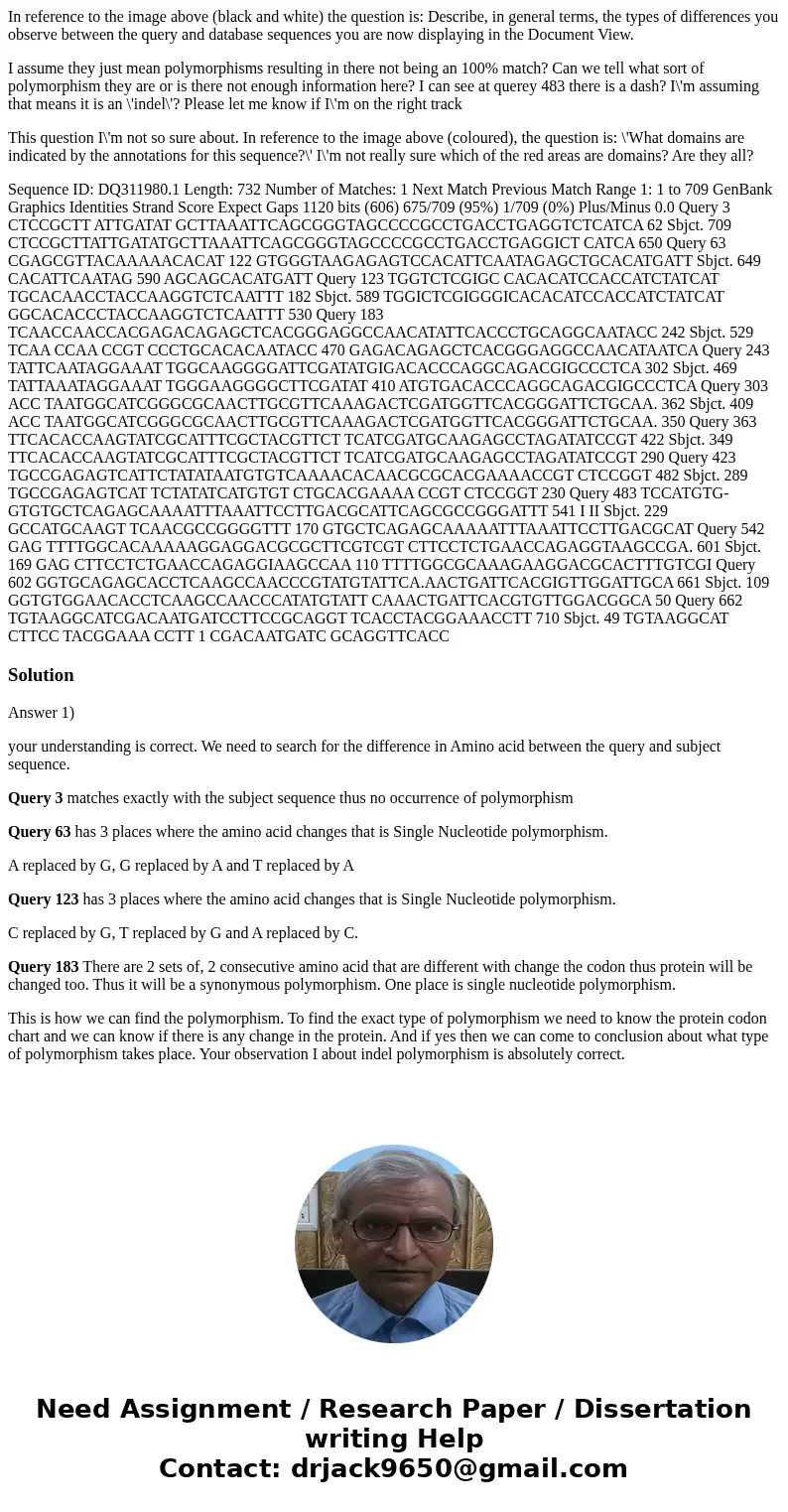In reference to the image above black and white the question
In reference to the image above (black and white) the question is: Describe, in general terms, the types of differences you observe between the query and database sequences you are now displaying in the Document View.
I assume they just mean polymorphisms resulting in there not being an 100% match? Can we tell what sort of polymorphism they are or is there not enough information here? I can see at querey 483 there is a dash? I\'m assuming that means it is an \'indel\'? Please let me know if I\'m on the right track
This question I\'m not so sure about. In reference to the image above (coloured), the question is: \'What domains are indicated by the annotations for this sequence?\' I\'m not really sure which of the red areas are domains? Are they all?
Sequence ID: DQ311980.1 Length: 732 Number of Matches: 1 Next Match Previous Match Range 1: 1 to 709 GenBank Graphics Identities Strand Score Expect Gaps 1120 bits (606) 675/709 (95%) 1/709 (0%) Plus/Minus 0.0 Query 3 CTCCGCTT ATTGATAT GCTTAAATTCAGCGGGTAGCCCCGCCTGACCTGAGGTCTCATCA 62 Sbjct. 709 CTCCGCTTATTGATATGCTTAAATTCAGCGGGTAGCCCCGCCTGACCTGAGGICT CATCA 650 Query 63 CGAGCGTTACAAAAACACAT 122 GTGGGTAAGAGAGTCCACATTCAATAGAGCTGCACATGATT Sbjct. 649 CACATTCAATAG 590 AGCAGCACATGATT Query 123 TGGTCTCGIGC CACACATCCACCATCTATCAT TGCACAACCTACCAAGGTCTCAATTT 182 Sbjct. 589 TGGICTCGIGGGICACACATCCACCATCTATCAT GGCACACCCTACCAAGGTCTCAATTT 530 Query 183 TCAACCAACCACGAGACAGAGCTCACGGGAGGCCAACATATTCACCCTGCAGGCAATACC 242 Sbjct. 529 TCAA CCAA CCGT CCCTGCACACAATACC 470 GAGACAGAGCTCACGGGAGGCCAACATAATCA Query 243 TATTCAATAGGAAAT TGGCAAGGGGATTCGATATGIGACACCCAGGCAGACGIGCCCTCA 302 Sbjct. 469 TATTAAATAGGAAAT TGGGAAGGGGCTTCGATAT 410 ATGTGACACCCAGGCAGACGIGCCCTCA Query 303 ACC TAATGGCATCGGGCGCAACTTGCGTTCAAAGACTCGATGGTTCACGGGATTCTGCAA. 362 Sbjct. 409 ACC TAATGGCATCGGGCGCAACTTGCGTTCAAAGACTCGATGGTTCACGGGATTCTGCAA. 350 Query 363 TTCACACCAAGTATCGCATTTCGCTACGTTCT TCATCGATGCAAGAGCCTAGATATCCGT 422 Sbjct. 349 TTCACACCAAGTATCGCATTTCGCTACGTTCT TCATCGATGCAAGAGCCTAGATATCCGT 290 Query 423 TGCCGAGAGTCATTCTATATAATGTGTCAAAACACAACGCGCACGAAAACCGT CTCCGGT 482 Sbjct. 289 TGCCGAGAGTCAT TCTATATCATGTGT CTGCACGAAAA CCGT CTCCGGT 230 Query 483 TCCATGTG-GTGTGCTCAGAGCAAAATTTAAATTCCTTGACGCATTCAGCGCCGGGATTT 541 I II Sbjct. 229 GCCATGCAAGT TCAACGCCGGGGTTT 170 GTGCTCAGAGCAAAAATTTAAATTCCTTGACGCAT Query 542 GAG TTTTGGCACAAAAAGGAGGACGCGCTTCGTCGT CTTCCTCTGAACCAGAGGTAAGCCGA. 601 Sbjct. 169 GAG CTTCCTCTGAACCAGAGGIAAGCCAA 110 TTTTGGCGCAAAGAAGGACGCACTTTGTCGI Query 602 GGTGCAGAGCACCTCAAGCCAACCCGTATGTATTCA.AACTGATTCACGIGTTGGATTGCA 661 Sbjct. 109 GGTGTGGAACACCTCAAGCCAACCCATATGTATT CAAACTGATTCACGTGTTGGACGGCA 50 Query 662 TGTAAGGCATCGACAATGATCCTTCCGCAGGT TCACCTACGGAAACCTT 710 Sbjct. 49 TGTAAGGCAT CTTCC TACGGAAA CCTT 1 CGACAATGATC GCAGGTTCACCSolution
Answer 1)
your understanding is correct. We need to search for the difference in Amino acid between the query and subject sequence.
Query 3 matches exactly with the subject sequence thus no occurrence of polymorphism
Query 63 has 3 places where the amino acid changes that is Single Nucleotide polymorphism.
A replaced by G, G replaced by A and T replaced by A
Query 123 has 3 places where the amino acid changes that is Single Nucleotide polymorphism.
C replaced by G, T replaced by G and A replaced by C.
Query 183 There are 2 sets of, 2 consecutive amino acid that are different with change the codon thus protein will be changed too. Thus it will be a synonymous polymorphism. One place is single nucleotide polymorphism.
This is how we can find the polymorphism. To find the exact type of polymorphism we need to know the protein codon chart and we can know if there is any change in the protein. And if yes then we can come to conclusion about what type of polymorphism takes place. Your observation I about indel polymorphism is absolutely correct.

 Homework Sourse
Homework Sourse